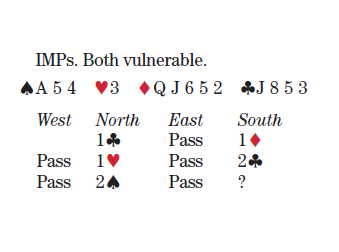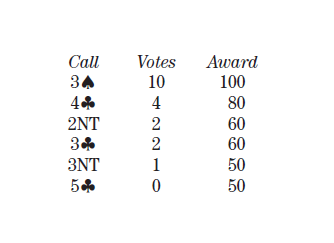
What’s your call?
| 2NT | ||||
| 3♣ | 3♦ | 3♥ | 3♠ | 3NT |
| 4♣ | 4♦ | 4♥ | 4♠ | 4NT |
| 5♣ | 5♦ | 5♥ | 5♠ | 5NT |
| 6♣ | 6♦ | 6♥ | 6♠ | 6NT |
| 7♣ | 7♦ | 7♥ | 7♠ | 7NT |
| Dbl | Pass |
The 3♠ bidders outweigh everyone else. Meckstroth, always a man of few words, says, “3♠ should describe my shape perfectly.”
Robinson elaborates. “Partner must be 3=4=1=5. If he has:
![]()
he has a good play for 5♣. I will show him my singleton heart and let him make the final decision. We don’t want to be in 5♣ if he has wasted heart values.”
Like Robinson, Sanborn offers 3♠ because it completes the pattern description and assists partner in judging the combined assets. “This hand could be useful, or non-fitting if partner’s hearts are, say, ♥K Q 10 9 and her spades are ♠J–x–x.”
Walker, who describes the ♦Q J as “trash,” bids 3♠ because “the other features of this hand warrant cooperation. Notrump isn’t appealing opposite a diamond void. 3♠ should show the heart shortness, and my failure to bid notrump should show not much wastage in diamonds.”
Giragosian agrees. “My hand looks pretty good in this auction. Why not show the spade card and see where partner is headed?”
The Sutherlins see partner’s bids as describing “a hand just short of a jump-shift strength. We have limited our hand. He shouldn’t play us for four spades, since we would have responded 1♠ instead of 1♦ or 2♣. Best to raise spades (pinpointing the singleton heart) and leave open the game choices of 4♠, 3NT or 5♣. Let partner decide.”
The Joyces zero in on the usefulness of 3♠ in describing the hand’s heart shortness. “Maybe the stiff heart is the key to the bank.”
Boehm bids 3♠ “suggesting a high spade. This seems like a good hand for clubs or notrump.”
The 4♣ers bypass 3NT to stress the eminent suitability of the hand for play in a club contract.
“Partner is interested in something, and my hand has just grown for the first time in the auction,” says Lawrence. “3♠ is also acceptable, but only if it is agreed that I will not sit for 3NT.”
“We think partner is patterning out with extras,” say the Coopers. “Although our diamond cards are not working, we do have four clubs, a stiff heart and a side ace, so — vulnerable at IMPs — let’s invite the most likely game.”
Falk and Stack hang back in 3♣. “Partner did not jump shift, so while he has extras, my hand is merely decent, not great,” says Falk. “Partner might be 4=4=1=4, 4=4=0=5 or even 3=4=1=5. 4♣ requires a lot of tricks, and my hand opposite most of those distributions may be far too ambitious.”
Stack, too, anticipates the worst — partner’s 4=4=1=4 hand and alert defenders leading trumps. “It is tempting to bid notrump or suggest playing a Moysian fit by raising to 3♠.”
Cohen and the Gordons bid 2NT. “I have a little extra and diamonds well-stopped,” says Cohen. “This also feels like another near-unanimous panel — a prediction that always makes the problem selectors look bad (not this time, Larry) — and risks making me look silly.” No comment.
The Gordons call 2NT “the middle road.” They acknowledge, “Diamonds are wasted in a suit. It isn’t 100% that partner has four spades, and if he does, it isn’t 100% that spades are the right strain.”
Meyers has no questions and no doubts. “3NT. Partner should have 16–17 HCP with, at most, one diamond. I think I have enough for game.”

